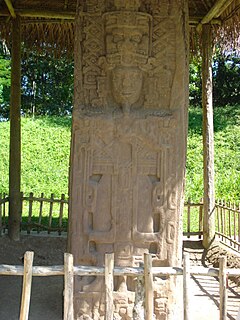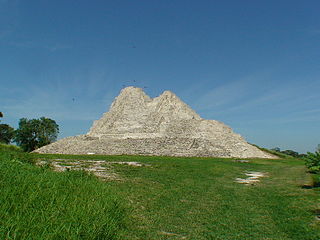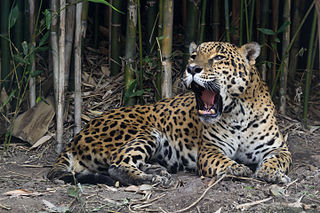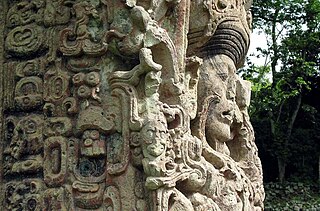
During the 7th and 8th centuries in Mesoamerica, there was an evident shift in the roles women played in ancient Maya society as compared with the previous two centuries. It was during this time that there was a great deal of political complexity seen both in Maya royal houses as well as in the Maya area. Warfare was a significant factor in political competition and marriage was one of the ways that alliances were made between the different polities. This was accompanied by a shift in women's roles from wife and mother to playing integral parts in courtly life, such as participating in rituals involving the supernatural world and at times ruling individual polities.

Itzamnaaj Kʼawiil was a Mayan king of Dos Pilas. He was the third known ruler of that place. He is also known as the Ruler 2 and Shield God K.

Uchaʼan Kʼin Bʼalam was the fourth Mayan king of Dos Pilas. He is also known as the Ruler 3, Master of Sun Jaguar, Scroll-head God K, Spangle-head and Jewelled-head. His title was "He of Five Captives".

Not to be confused with Ajaw Bʼot, king of Seibal.
Tok Casper was the first known king of Maya city-state Quiriguá in what is now Guatemala. He ruled 426–?. Casper took the throne when he was only thirteen, but ruled for 50 years. K'inich Yax K'uk' Mo', king of Copán, installed Tok Casper upon the throne.

Tutuum Yohl Kʼinich was the second known king of Maya city-state Quiriguá in Guatemala.

Jade Sky was a king of the Maya city-state Quirigua in Guatemala, a successor of Sky Xul, who was maybe a son of great king K'ak' Tiliw Chan Yopaat.

Yuknoom Chʼeen I was the first known Maya king of the Kaan Kingdom. He was maybe a father of King Tuun Kʼabʼ Hix.

Ix Ekʼ Naah, also known as the Snake Lady of Palenque, was a Maya queen of the Kaan kingdom in Campeche. She was a daughter of Lady Bʼakabʼ, wife of the King Tuun Kʼabʼ Hix and had a daughter who married one lord, Prince of La Corona.

Moral-Reforma is a Maya archaeological site in Mexico, about 70 miles (113 km) northeast of Palenque.
Ku Ix was the fourth dynastic ruler Copan. Ku Ix built a new phase of Temple 26 at the city, over the Motmot phase, nicknamed Papagayo.
Ruler 3 is the designated title for the third ruler of Copan after the reformation by K'inich Yax K'uk' Mo'.
Muyal Jol was the sixth ruler of Copan.
Ruler 5 is the designated title for the fifth ruler of Copan after the reformation by K'inich Yax K'uk' Mo'.
Bʼalam Nahn was the seventh ruler of Copan after the reformation initiated by Kʼinich Yax Kʼukʼ Moʼ. His nicknames were Jaguar Mirror and Waterlily-Jaguar. Bʼalam Nehn was the first king to actually record his position in the dynastic succession, declaring that he was seventh in line from Kʼinich Yax Kʼukʼ Moʼ. Stela 15 records that he was already ruling Copán by AD 504. Bʼalam Nehn is the only king of Copán to be mentioned in a hieroglyphic text from outside of the southeastern Maya region. His name appears in a text on Stela 16 from Caracol, a site in Belize. The stela dates to AD 534 but the text is not well understood. Bʼalam Nehn undertook major construction projects in the Acropolis, building over an early palace with a number of important structures.
Wil Ohl Kʼinich was the eighth ruler of the Maya city state Copan. He was nicknamed Head on Earth by archaeologists.
Sak-Lu was the ninth ruler of the Maya city state Copán.
Kʼakʼ Joplaj Chan Kʼawiil was installed as the 14th dynastic ruler of Copán on 7 June 738, 39 days after the execution of Uaxaclajuun Ubʼaah Kʼawiil. Little is known of his reign due to the lack of monuments raised after Quiriguá's surprise victory. Copán's defeat had wider implications due to the fracturing of the city's domain and the loss of the key Motagua River trade route to Quiriguá. The fall in Copán's income and corresponding increase at Quiriguá is evident from the massive commissioning of new monuments and architecture at the latter city and Copán may even have been subject to its former vassal. Kʼakʼ Joplaj Chan Kʼawiil died in January 749.

Nuun Ujol Kʼinich, was an ajaw of the Maya city of Tikal. He ruled sometime between 794 and 810 and he was probably father of Dark Sun.
















